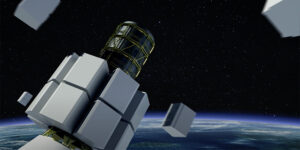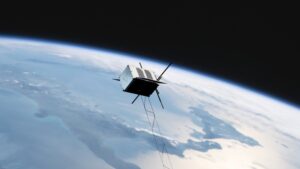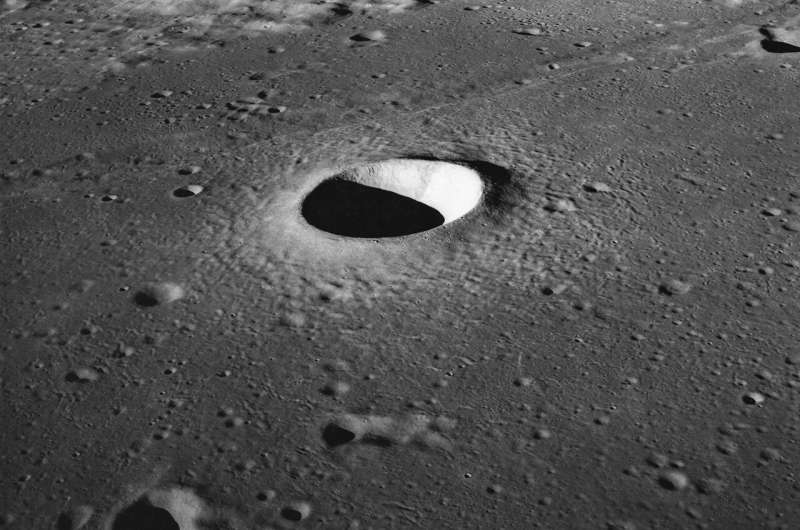O3b mPOWER get first cloud customer, on track for launch even as COVID-19 issues loom
Tuesday, 17 August 2021 16:25
Microsoft is pivoting from being a partner to also a customer of SES’ next-generation O3b mPOWER broadband constellation, which SES said remains on schedule despite an ongoing threat of supply chain disruption from COVID-19.
RUAG Space: World leader for satellite separation systems
Tuesday, 17 August 2021 13:01
Nearly 1000 satellites were separated in orbit with separation systems from RUAG Space. The company is leading the commercial market in this area.
Rocket Lab to launch Finnish cubesat
Tuesday, 17 August 2021 10:10
A Finnish cubesat designed to test satellite deorbiting technologies will launch on a Rocket Lab Electron after delays with its original launch on a Momentus tug.
Former Commerce official Kevin O’Connell joins board of advisors of startup Kayhan Space
Tuesday, 17 August 2021 09:00
Kayhan Space, a startup focused on space situational awareness and collision avoidance technologies, announced Aug. 17 that Kevin O’Connell has joined its board of advisors.
SpaceWERX launch drives AFWERX small business focus on universities and on-orbit capability
Tuesday, 17 August 2021 07:19 On August 19, SpaceWERX will officially launch. The kickoff will include a virtual Space Force Pitch Day highlighting the key partnership between the Department of the Air Force and small businesses by awarding up to $34 million to innovative startups competing for Small Business Innovation Research Phase II contracts. At the launch, SpaceWERX will also announce key initiatives to jumpstart the
On August 19, SpaceWERX will officially launch. The kickoff will include a virtual Space Force Pitch Day highlighting the key partnership between the Department of the Air Force and small businesses by awarding up to $34 million to innovative startups competing for Small Business Innovation Research Phase II contracts. At the launch, SpaceWERX will also announce key initiatives to jumpstart the US sensor architecture not sufficient to detect hypersonic missiles
Tuesday, 17 August 2021 07:19 US military's sensor architecture is not sufficient to effectively detect hypersonic missiles across the world while Russia today is the leading nation for this technology, US Strategic Command chief Adm. Charles Richard said on Thursday.
"It [hypersonic technology] creates challenges that permeate the responsibility of STRATCOM, SPACECOM, NORTHCOM, and every other combatant command," Rich
US military's sensor architecture is not sufficient to effectively detect hypersonic missiles across the world while Russia today is the leading nation for this technology, US Strategic Command chief Adm. Charles Richard said on Thursday.
"It [hypersonic technology] creates challenges that permeate the responsibility of STRATCOM, SPACECOM, NORTHCOM, and every other combatant command," Rich Space EA Systems delivers satellite-enabled quantum-proof cybersecurity and innovation
Tuesday, 17 August 2021 07:19 Space EA's new post-quantum encryption network defeats quantum's destructive effect against security, while enabling satellite architectures and communication networks the ability to harness quantum's power for DoD and commercial clients in the space sector.
The advent of quantum computing renders all current security obsolete, causing a perfect storm with the convergence of more and more
Space EA's new post-quantum encryption network defeats quantum's destructive effect against security, while enabling satellite architectures and communication networks the ability to harness quantum's power for DoD and commercial clients in the space sector.
The advent of quantum computing renders all current security obsolete, causing a perfect storm with the convergence of more and more USSF establishes 2nd Field Command, Guetlein assumes command
Tuesday, 17 August 2021 07:19 The U. S. Space Force established the second of its three field commands in a ceremony here Aug. 13, as Space Force Lt. Gen. Michael A. Guetlein assumed command of Space Systems Command.
Speaking during the establishment ceremony, Space Force Chief of Space Operations Gen. John W. "Jay" Raymond emphasized the important work that lies ahead for Guardians and Airmen of SSC. "America relies o
The U. S. Space Force established the second of its three field commands in a ceremony here Aug. 13, as Space Force Lt. Gen. Michael A. Guetlein assumed command of Space Systems Command.
Speaking during the establishment ceremony, Space Force Chief of Space Operations Gen. John W. "Jay" Raymond emphasized the important work that lies ahead for Guardians and Airmen of SSC. "America relies o NASA tests machine to power the future of aviation propulsion
Tuesday, 17 August 2021 07:19 A one-megawatt electric motor that could help propel future, more environmentally friendly and economically sustainable aircraft was tested during April and May by NASA and its industry and academic partners.
The center of attention is an electric machine that can work either as an electric motor to turn propellers or large engine fans, or a generator to produce one million watts of power
A one-megawatt electric motor that could help propel future, more environmentally friendly and economically sustainable aircraft was tested during April and May by NASA and its industry and academic partners.
The center of attention is an electric machine that can work either as an electric motor to turn propellers or large engine fans, or a generator to produce one million watts of power NASA at your table: where food meets methane
Tuesday, 17 August 2021 07:19 Today, human sources are responsible for 60% of global methane emissions, coming primarily from the burning of fossil fuels, decomposition in landfills and the agriculture sector. Nearly a quarter of methane emissions can be attributed to agriculture, much of which is from raising livestock. Rice cultivation and food waste are also important sources of agricultural methane, as nearly a third of
Today, human sources are responsible for 60% of global methane emissions, coming primarily from the burning of fossil fuels, decomposition in landfills and the agriculture sector. Nearly a quarter of methane emissions can be attributed to agriculture, much of which is from raising livestock. Rice cultivation and food waste are also important sources of agricultural methane, as nearly a third of Indian Space Research Organisation fails to place earth observation satellite in orbit
Tuesday, 17 August 2021 07:19 On Thursday, the Indian Space Research Organisation (ISRO) was scheduled to launch Earth observation satellite EOS-03 on the GSLV launcher. The mission was initially expected to be carried out in March 2020 but was postponed due to the coronavirus pandemic.
The Earth observation satellite EOS-03, launched on Thursday from the Satish Dhawan Space Centre (SDSC) SHAR in Sriharikota, failed to
On Thursday, the Indian Space Research Organisation (ISRO) was scheduled to launch Earth observation satellite EOS-03 on the GSLV launcher. The mission was initially expected to be carried out in March 2020 but was postponed due to the coronavirus pandemic.
The Earth observation satellite EOS-03, launched on Thursday from the Satish Dhawan Space Centre (SDSC) SHAR in Sriharikota, failed to Blue Origin sues NASA over SpaceX Moon contract
Tuesday, 17 August 2021 07:17
Blue Origin, the space company owned by Jeff Bezos, is suing the US government over its decision to award a massive Moon exploration contract to its competitor SpaceX, it said in a statement Monday.
The company has filed a suit with the US Court of Federal Claims "in an attempt to remedy the flaws" in how the contract was awarded, according to the statement.
The human landing system (HLS) contract, worth $2.9 billion, was given to SpaceX, owned by Bezos's billionaire rival Elon Musk, in April.
It was protested by the other bidders, who argued NASA was required to make multiple awards and that the evaluation process was unfair.
"We firmly believe that the issues identified in this procurement and its outcomes must be addressed to restore fairness, create competition, and ensure a safe return to the Moon for America," Blue Origin said.
Since losing the contract, Blue Origin has strongly lobbied to have the decision reversed.
Europe's Vega rocket blasts off with Airbus observation satellite
Tuesday, 17 August 2021 07:16
A European Vega rocket lifted off Monday night from French Guiana carrying an Earth observation satellite and four miniature "cubesats".
It was the second launch this year of the Vega, a crucial component of European ambitions to compete with rivals such as Elon Musk's SpaceX in the booming commercial aerospace market.
The rocket blasted off from the Guiana Space Centre in Kourou at 10:47 pm (0147 GMT), successfully delivering the satellites in just under two hours.
Its main cargo was a high-resolution satellite, the second of four for a new Earth observation constellation operated by Airbus. The first was put in orbit in April by a Vega rocket.
The Pleiades Neo constellation will offer high-resolution imaging of Earth for military or civilian uses such as disaster response, according to Airbus.
Vega's operator Arianespace is a subsidiary of the ArianeGroup, of which Airbus owns half.
Musk says next Moon landing will probably be sooner than in 2024
Tuesday, 17 August 2021 03:06 NASA reportedly paid $300 million to SpaceX on 30 July to turn Starship into a crewed Moon lander for its Human Landing System (HLS) programme. In total, the project may require up to $3 billion in funding.
Once again, Elon Musk has shared his optimistic views on space exploration, saying that Moon travel may be closer than it seems. Replying to the Twitter account "Everything Artemis", wh
NASA reportedly paid $300 million to SpaceX on 30 July to turn Starship into a crewed Moon lander for its Human Landing System (HLS) programme. In total, the project may require up to $3 billion in funding.
Once again, Elon Musk has shared his optimistic views on space exploration, saying that Moon travel may be closer than it seems. Replying to the Twitter account "Everything Artemis", wh Trio of orbiters shows small dust storms help dry out Mars
Tuesday, 17 August 2021 03:06 By combining observations from three international spacecraft at Mars, scientists were able to show that regional dust storms play a huge role in drying out the Red Planet. Dust storms heat up higher altitudes of the cold Martian atmosphere, preventing water vapor from freezing as usual and allowing it to reach farther up.
In the higher reaches of Mars, where the atmosphere is sparse, wate
By combining observations from three international spacecraft at Mars, scientists were able to show that regional dust storms play a huge role in drying out the Red Planet. Dust storms heat up higher altitudes of the cold Martian atmosphere, preventing water vapor from freezing as usual and allowing it to reach farther up.
In the higher reaches of Mars, where the atmosphere is sparse, wate 
